 |
 |
 |
| |
ART in Acute Infection Quells Inflammation But Does Not Restore Gut CD4s
|
| |
| |
(from Jules: below following this report are the slides & then links to relevant recent studies regarding early ART & that it limits reservoirs but after ART stops HIV returns; inflammation/activation appears early during acute infection & is associated with reservoir establishment, early ART can limit viral replication which results in limiting inflammation/activation suggesting this results in limited reservoir size which may be a benefit in trying to get a functional cure in patients. In a recent study published in the journal Nature, link to full text below "Rapid seeding of the viral reservoir prior to SIV viraemia in rhesus monkeys" the authors report the results of treating monkeys with ART 3 days after HIV-infection.)
20th International AIDS Conference, July 20-25, 2014, Melbourne
Mark Mascolini
Antiretroviral therapy (ART) begun during acute HIV infection in 39 Thai patients reversed gastrointestinal (GI) damage and quelled inflammation and immune activation [1]. But 2 years of therapy did not restore gut CD4 cells to normal levels.
A team from the Frederick National Laboratory for Cancer Research and other US and Thai centers noted that the GI tract is an early target of HIV. Infection swiftly depletes CD4 cells in the gut lamina propria (mucous membrane) and damages the GI epithelial barrier. Inflammation and microbial translocation are among the results. ART started early in the course of infection can protect peripheral CD4 cells, but it remains unclear whether prompt therapy also blocks GI damage and prevents CD4-cell loss from gut lamina propria.
The investigators collaborated with the RV254 study group, which identified a cohort of Thai patients with acute HIV infection. In a previous publication, the RV254 team reported that treatment of acute infection with tenofovir, emtricitabine, efavirenz, raltegravir, and maraviroc lowered gut HIV RNA to below 50 copies/mL in blood and get and reduced HIV DNA in blood and gut in some participants [2].
The new study involved 39 people with acute HIV infection, 17 with Fiebig stage 1 or 2 infection and 22 with Fiebig stage 3. Fiebig stage 1 and 2 are considered early acute infection and Fiebig 3 as later acute infection. RV254 researchers collected blood samples and gut biopsies at the first visit--before ART began. Follow-up sampling occurred after 24 and 96 weeks of treatment. The investigators used a double-staining technique to count CD4 cells in lamina propria. This analysis included 5 Thai individuals with chronic HIV infection and 10 HIV-negative Thais.
At the first study visit, before ART, few Fiebig 1/2 patients had a normal number of CD4s and most had already lost massive quantities of these HIV targets. Fiebig 3 patients, with more evolved HIV infection than the Fiebig 1/2 group, had lamina propria CD4 levels similar to those of chronically infected people.
For on-treatment analyses, the investigators pooled the Fiebig 1/2 and Fiebig 3 groups. They found that after 24 and 96 weeks of ART, CD4 counts in lamina propria remained significantly lower than those of HIV-negative people and did not improve significantly from pre-ART levels.
Because polymorphonuclear (PMN) cell infiltration of the GI tract reflects GI damage, the researchers counted PMNs in biopsies of study participants. At the first study visit, before ART began, PMN numbers were higher than in HIV-negative controls, especially in Fiebig 1/2 patients, a finding indicating gut damage even at this early stage of HIV infection. Once more pooling the Fiebig 1/2 and Fiebig 3 groups, the researchers found that PMNs in HIV-positive people treated for 24 weeks were no longer significantly greater than in the HIV-negative group, a finding indicating improvement of GI damage and dampened inflammation and immune activation.
The researchers concluded that early ART for acute HIV infection "rapidly attenuates GI damage, inflammation and immune activation, maintained at baseline levels after 2 years." But ART for acute infection and for 2 years thereafter could not forestall briskly declining CD4 levels in gut lamina propria or restore those levels.
References
1. Deleage C, Schuetz A, Morcock D, et al. Early treatment during HIV-1 acute infection attenuates GI damage, inflammation and immune activation but does not prevent CD4+ T cell depletion in the lamina propria AIDS 2014. 20th International AIDS Conference. July 20-25, 2014. Melbourne. Abstract WEAA0105.
2. Ananworanich J, Schuetz A, Vandergeeten C, et al. Impact of multi-targeted antiretroviral treatment on gut T cell depletion and HIV reservoir seeding during acute HIV infection. PLoS One. 2012;7:e33948. http://www.natap.org/2012/HIV/acutejournal.pone.0033948.pdf
http://www.plosone.org/article/info%3Adoi%2F10.1371%2Fjournal.pone.0033948
-----------------------------


------------------------
Program abstract
Background: The gastrointestinal tract (GI) is an early site of viral replication and pathology in HIV infection, manifested by significant depletion of lamina propria (LP) CD4+T cells and GI epithelial barrier damage leading to microbial translocation and associated inflammation. While early intervention with HAART in acute infection may prevent peripheral CD4+T cell loss, it is unclear if patients can be identified and treated early enough to abrogate these early pathological effects in the GI. In this study we analyzed GI LP CD4+T cell population size, GI damage and other aspects of GI immunity before and after early HAART initiation in a cohort of acute HIV infected patients in Thailand.
Methods: 45 Thai patients underwent sigmoid colon biopsy (day 0, 6 and 24 month): 30 untreated acute HIV-infected (10 Fiebig I (FI), 4 FII, 12 FIII and 4 FIV/V), 5 untreated chronically HIV infected and 10 HIV uninfected patients. The 30 acute infected patients were randomized to receive classical HAART (tenofovir/emtricitabine/efavirenz) or mega HAART (supplemented with raltegravir/maraviroc) after the first biopsy. Immunohistochemistry and quantitative image analysis was performed at day 0 and longitudinally (6, 24 months) to measure the GI damage (MPO staining), inflammation (MxA, TNFa), immune activation (KI67) and the CD4+T cell population size in the LP.
Results: While the magnitude of GI damage (MPO), immune activation (KI67) and inflammation (MxA and TNFa) were significantly increased during acute HIV-1 infection (day 0), all of these parameters were significantly down-regulated after 6 month of HAART. While the mean population size of CD4T cells in the LP in FI patients were similar to HIV negative controls, all other patients (FII-V) had significantly depleted LP CD4+T cells at day 0. In addition, after 6 months of HAART all acutely infected treated patients had significant depleted LP CD4+T cells that persisted through 24 months of treatment.
Conclusions: Early HAART intervention in acutely HIV-1 infected patients rapidly attenuates GI damage, inflammation and immune activation, maintained at baseline levels after 2 years. However, early HAART intervention was not able to prevent the depletion of LP CD4+T cells nor was it able to restore CD4+T cells after 24 months of HAART.
---------------------------------




The GI tract is a major site of HIV replication.
HIV infection lead to a massive depletion of CD4T cells and a local inflammation initial damage in the GI tract Epi barrier leading to microbial translocation and associated with massive ongoing inflammation.
The description of this Early process required RM Model
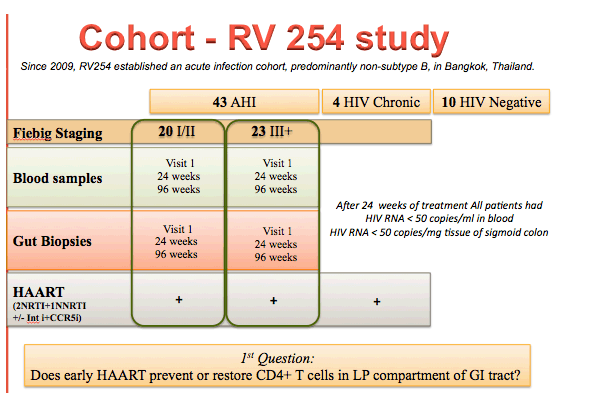
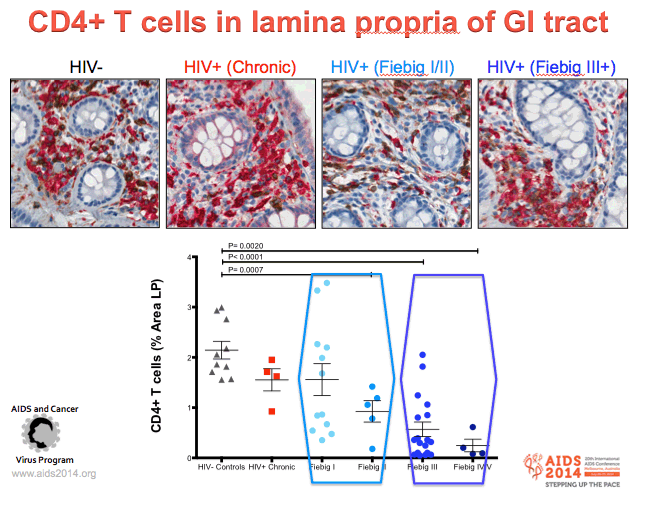
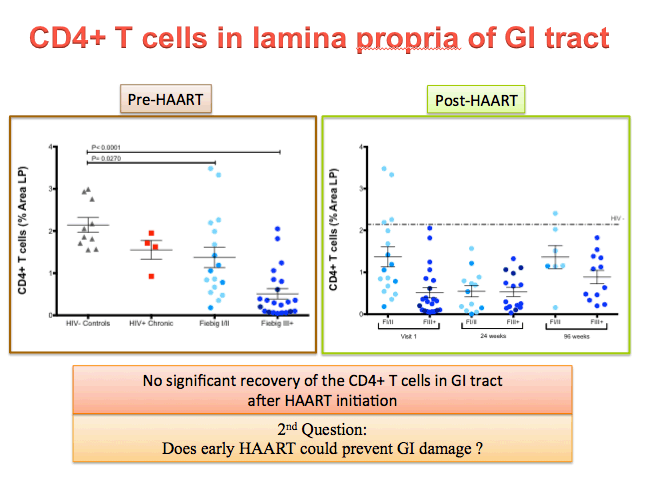

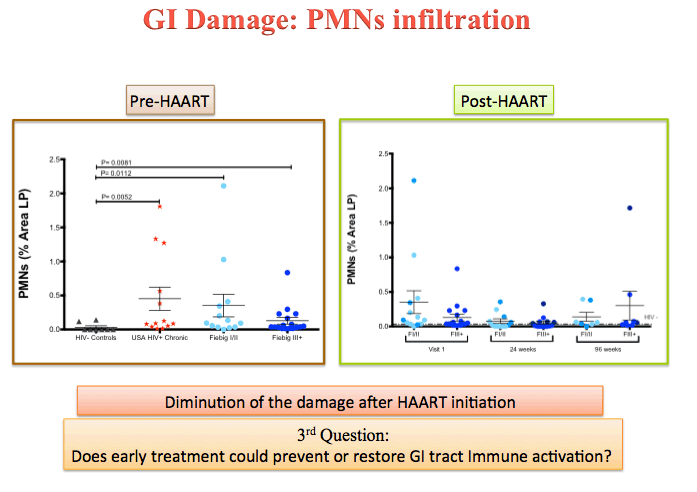
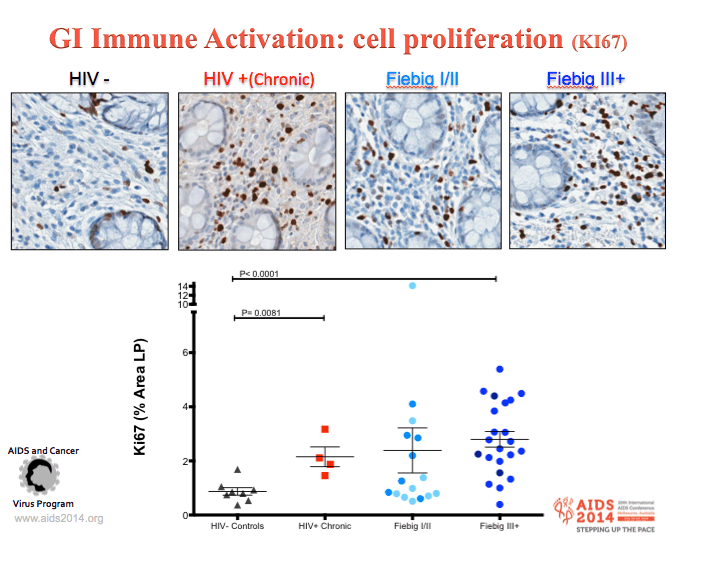
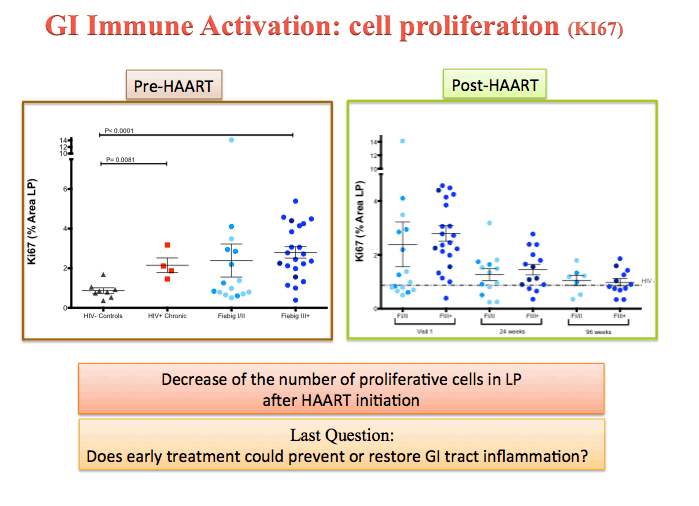
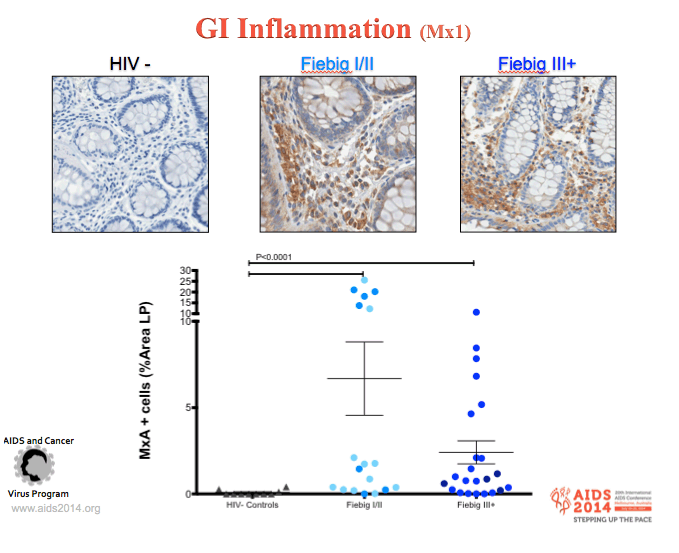

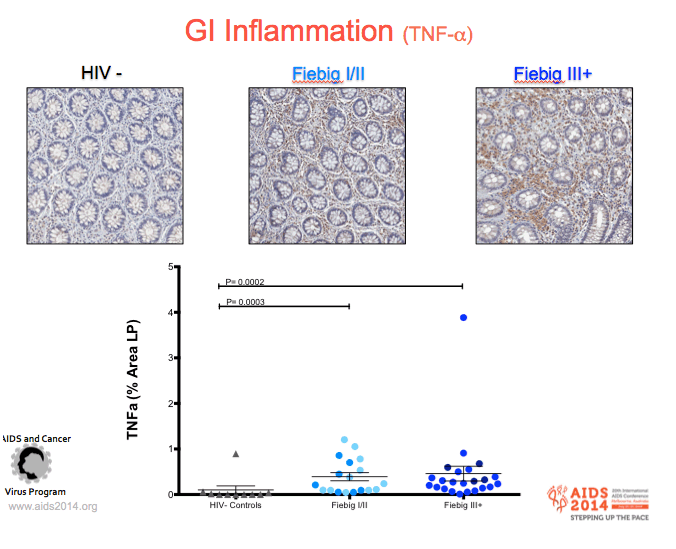
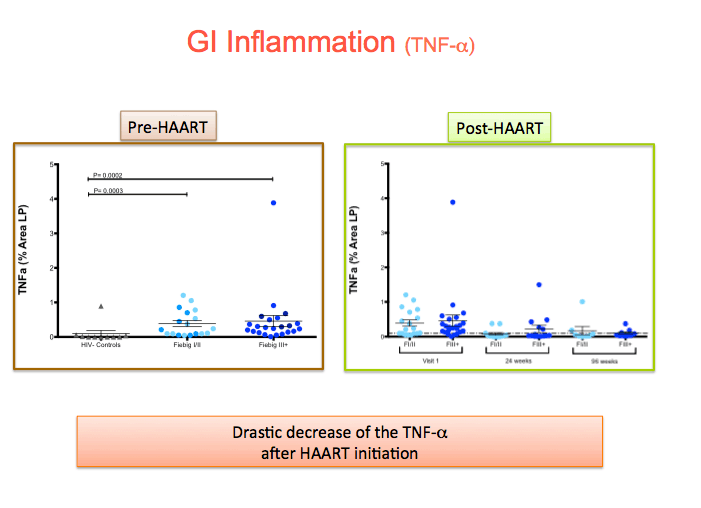
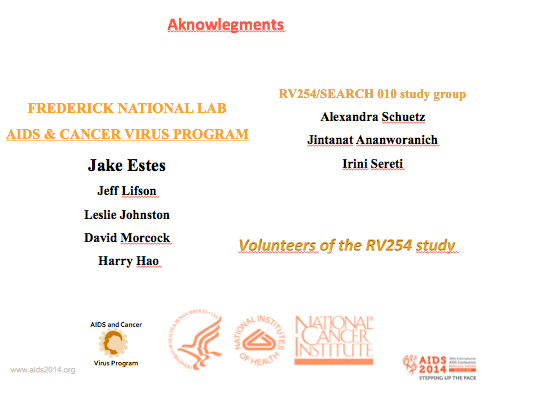
IAC/2014: cART in First Days of Life Limits Viral Reservoir Size in 4 Canadian Children........http://www.natap.org/2014/IAC/IAC_13.htm These four cases double the number of reported children with undetectable HIV DNA after starting cART in the first days of life. But as the Mississippi baby case shows, undetectable HIV DNA in a cART-treated child does not guarantee viral suppression when cART stops [2].
CROI/2014: ART in Acute Infection Limits Viral Reservoirs in Three-Group Monkey Comparison......http://www.natap.org/2014/CROI/croi_79.htm.....Delaying antiretroviral therapy (ART) for as few as 3 days during the "hyperacute" phase of simian immunodeficiency virus (SIV) infection in macaque monkeys resulted in 10- to 100-fold higher viral reservoir sizes.......ART involved four antiretrovirals, tenofovir, emtricitabine, dolutegravir, and ritonavir-boosted darunavir. Two monkeys (group A) began treatment 7 days after SIV infection, before peak viral replication; 2 (group B) began treatment 10 days after infection, at or near peak viral replication; and 18 (group C) began treatment 42 days after infection, early in chronic infection..........Coculture could not detect replication-competent SIV in the 4 macaques treated 7 or 10 days after infection but remained detectable in macaques treated 42 days after infection. However, adoptive transfer of lymphocytes from animals treated 7 days after infection to 2 antiretroviral-naive macaques induced productive infection. And when ART stopped in the 4 macaques treated 7 to 10 days after infection, SIV RNA promptly rebounded in plasma........team proposed that "aggressive monitoring for acute [HIV] infection with immediate introduction of ART could profoundly influence treatment outcomes and enhance viral eradication strategies........And Deborah Persuad said "the data suggests 7 days is too late, we need to figure out what is that window of opportunity for early therapy to prevent reservoir establishment rather than just diminishing it to a point that I couldn't tell if she said we can or can't detect it but once therapy is stopped there is rebound viremia, so do you have plans to narrow that window, this is relevant to perinatal infection, in terms of how early should we treat to accomplish not minimal reservoir but complete blockage of reservoir formation. The presenter responded...they have done some studies...probably within 24-48 hours you probably would not get rebound but after that its probably too late"
CROI/2014: Inflammation in Acute HIV Infection Correlates with Blood and Gut CD4 T-cell Loss and HIV Viral Burden..........http://www.natap.org/2014/CROI/croi_188.htm......"these data suggest that days matter when halting viral replication to reduce the viral reservoir, intestinal CD4 depletion, and inflammation......Plasma levels of biomarkers of inflammation, microbial translocation (MT), fibrosis and coagulation correlated positively with plasma HIV viremia.....and with sigmoid HIV DNA levels......the earliest (4thG1) stage of acute infection is associated with lower cellular HIV burden in both peripheral blood & colonic mucosa & less immunologic damage (CD4 loss) in colonic mucosa. Biomarkers of inflammation & microbial translocation increase early in acute infection & are lowest in the 4thG1 & often highest at the 4th G2 stage of acute infection. Plasma HIV RNA & sCD14 levels are independently associated with sigmoid CD4 cell depletion, suggesting ongoing viral replication accelerates CD4 depletion & LPS-induced monocyte activation. TOGETHER, these data suggest that days matter when halting viral replication to reduce the viral reservoir, intestinal CD4 depletion & inflammation....high circulating TNF levels (inflammation) are associated with high plasma HIV RNA, high HIV DNA in PBMCs & the sigmoid colon, high HIV RNA in the sigmoid colon & low CD4 cells in the sigmoid colon. High HIV DNA in PBMCs is associated with high intestinal fatty acid binding protein (I-FAPB), reflecting enterocyte loss, and high sCD14 levels, reflecting LPS induced monocyte activation
Rapid seeding of the viral reservoir prior to SIV viraemia in rhesus monkeys...http://www.natap.org/2014/HIV/080414_01.htm....These data demonstrate that the viral reservoir is seeded rapidly after intrarectal SIV infection of rhesus monkeys, during the 'eclipse' phase, and before detectable viraemia. This strikingly early seeding of the refractory viral reservoir raises important new challenges for HIV-1 eradication strategies.......in the present study, initiation of suppressive ART even as early as day 3 after infection failed to eliminate the viral reservoir and did not prevent viral rebound despite 24 weeks of fully suppressive ART. In addition, our data (Fig. 4a) are consistent with clinical studies that have shown that the vast majority of HIV-1-infected individuals who initiate ART during acute infection show viral rebound after discontinuation of ART25, 26, 27......We show that the viral reservoir can be seeded substantially earlier than previously recognized. After intrarectal SIV infection of rhesus monkeys, the viral reservoir was seeded during the first few days of infection, during the eclipse phase, and before detectable viraemia, probably in the mucosal and lymphoid tissues that represent the first sites of viral replication17. Consistent with this finding, we observed proviral DNA in lymph nodes and in gastrointestinal mucosa but not in PBMCs in monkeys treated on day 3 after infection (Fig. 3a and Extended Data Fig. 5). The observation that the viral reservoir can be seeded before detectable viraemia suggests that substantial pathogenesis occurs in tissues in the first few days after mucosal virus exposure and prior to virus replication in peripheral blood, which has important implications for HIV-1 therapeutic and eradication strategies......These data indicate that initiation of ART on day 3 reduced levels of proviral DNA at week 24 by at least 2.2 log in PBMCs (P < 0.0001; Fig. 3f), 1.0 log in LNMCs (P = 0.004; Fig. 3g), and 0.9 log in GMMCs (P = not significant; Fig. 3h) as compared with initiation of ART on day 14. The high variability in the GMMC samples probably reflected sampling variation in this anatomical compartment. Compared to untreated animals, initiation of ART on day 3 reduced levels of proviral DNA at week 24 by at least 3.3 log in PBMCs (P < 0.0001; Fig. 3f) and 3.1 log in LNMCs (P < 0.0001; Fig. 3g).
This CROI/2014 Cure Report discusses the studies linked to above: HIV Pathogenesis, Innate Defense against HIV, and HIV Cure at CROI 2014, Boston - By David Margolis MD UNC Chapel Hill & the Collaboratory of AIDS Researchers for Eradication (CARE) (03/25/14)
Two other studies touted the benefit of immediate ART in acute/early infection, towards the goal of immune preservation and the restriction of reservoir size (a potential future benefit, rather than a current one). Schuetz ( abstract 77 http://www.croiwebcasts.org/console/player/22154?mediaType=slideVideo&) found that early ART initiation in the USAMC-AFRIMS Thai cohort study prevents the appearance of biomarkers said to correlate with disruption of the mucosal barrier, and that this was associated with lower levels of T cell activation. In 38 subjects in Fiebig stages I to III (acute infection) were enrolled and underwent sigmoid biopsy at baseline, 6 and 24 months after initiation of ART. 10 HIV uninfected and 5 ART-naive HIV+ controls were studied. HIV+ patients treated in Fiebig I/II exhibit levels of Th17 cells and CD8 T cell activation similar to HIV- subjects and maintain those levels under ART. This may prevent the loss of Th17 cells and subsequent CD8 T cell activation.
Okoye of the Oregon National Primate Research Center ( abstract 136LB http://www.croiwebcasts.org/console/player/22273?mediaType=slideVideo&) presented a analogous study of the effect of early ART in acute SIV Infection. Rhesus macaques were infected intravenously with SIVmac239 treated with tenofovir, emtricitabine, dolutegravir and darunavir boosted with ritonavir starting at day 7 (group A), day 10 (group B) or day 42 (group C) after viral exposure. Early ART, when initiated prior to peak virus replication, limited systemic virus dissemination and seeding of the reservoir in peripheral and extra lymphoid mucosal compartments. A delay as short as three days during the "hyperacute" phase can result in over a log higher tissue-based reservoir size, once therapy is started and maintained. Central memory T cells were found to be the major cell population containing SIV DNA in the early ART setting. Tissue biopsies showed persistence of cell-associated HIV RNA on ART, which persisted for longer times if ART was delayed. Early ART also decreased levels of cell-associated HIV DNA, with larger decreases seen with earlier ART. Virus was undetectable by coculture given the numbers of cells that could be collected, but using "adoptive transfer" of cells to an uninfected animal as few as 60 million cells transferred infection, but 3 million did not.
|
| |
|
 |
 |
|
|